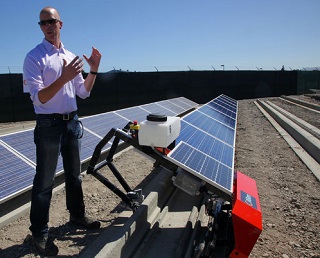From Guest Blogger Kara Masterson: Solar Panels Are More Practical and Economical Than Ever

Solar energy doesn’t just reduce monthly energy costs, it also reduces the social and environmental costs of dependence on fossil fuels. Solar energy, unlike fossil fuels, is sustainable and not subject to rising prices due to scarcity, either real or manufactured. One non-profit website has helped thousands of Americans calculate their potential cost savings based on factors specific to their location. It really is amazing to see how much money solar energy can save you down the road. It is definitely something worth looking into.
An article in the Scientific American points out that the cost of installing solar panels on a home has decreased by nearly 70 percent over the last ten to fifteen years. According to a recent report by Deutche Bank solar energy has achieved “price parity” with the power grid based on fossil fuels in Ten U.S. States already. They also predicted that if the energy tax credits that were due to expire this year were renewed, that price parity could be achieved by a majority of states within a very short time.
Surprisingly, some of the states on the top ten list of those that enjoy the highest solar energy cost savings aren’t states that enjoy the most sunshine. Arizona, California and Nevada enjoy both, and a Utah solar power provider is working towards their state earning a spot on the list. New York and New Jersey both hold spots on the list even though they don’t rank high in sunshine. Solar power really is being used more and more all over the world each year and it is just going to keep spreading.
The good news for consumers and the environment is that the tax credits due to expire this year have been extended. If you’ve been thinking of converting to solar energy, now is the best time to do it. Why? Because the tax credits of 30% have only been extended until 2019. After that, the credit will drop to 26%, then drop further to 22% before expiring completely in 2021. This is definitely a great time to invest in solar power while being able to save as much money as you can. The cheaper you can get it now the more of a payoff you can have in the future.
If reducing your monthly energy bills isn’t enough to make you consider going solar, consider this: A 2014 study conducted by U.S. Department of Energy concluded that rooftop solar added an average of $15,000 to a home’s resale market value. Some real estate experts believe that one day, home buyers will expect all homes to have them. Solar energy is definitely the future and soon it will be something that everyone will look for in a new home. Your house will definitely be a lot more likely to sell if it is solar powered. Overall, solar energy has a lot of different benefits so it is definitely something worth looking into today.

From the headline:
“Solar Panels Are More Practical and Economical Than Ever”
The basic question is for whom? Without the subsidies, they don’t seem to be practical for anyone. The stated costs per KWH generally consider only the panels themselves, as if anyone could plug a hair dryer directly into a solar panel.
The costs per KWH should include everything required to get solar energy from the sun to the end user and permit using the power 24 hours per day 365 days per year. The results would be somewhat different.